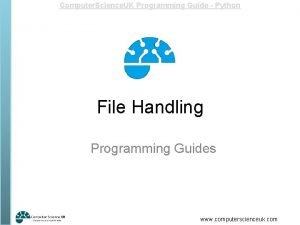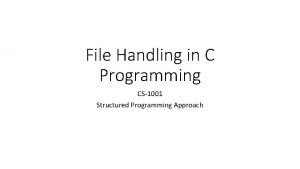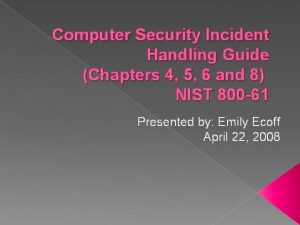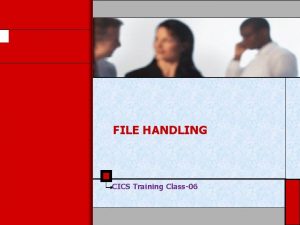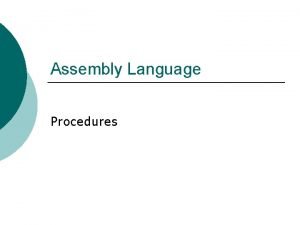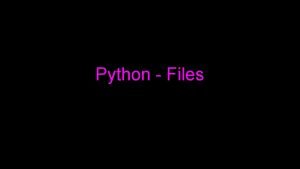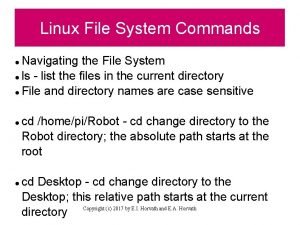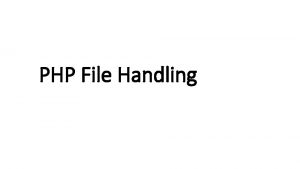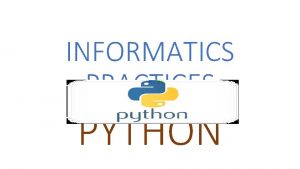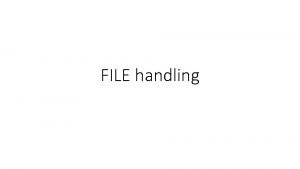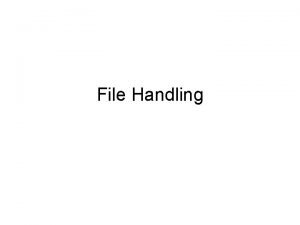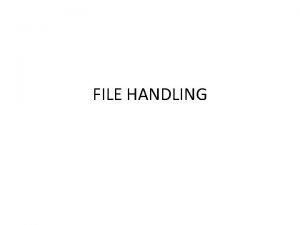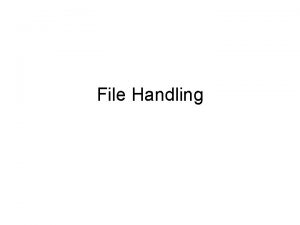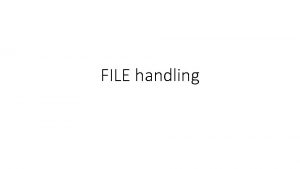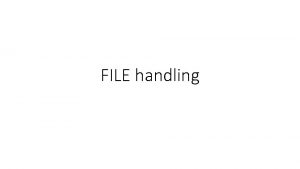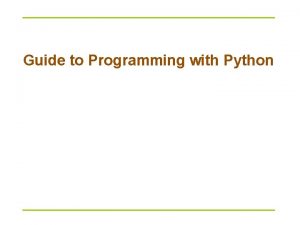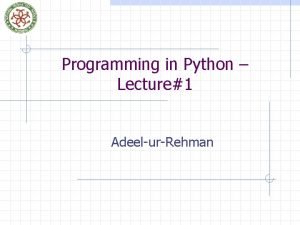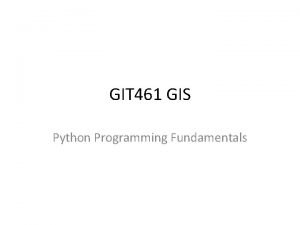Computer Science UK Programming Guide Python File Handling






















- Slides: 22

Computer. Science. UK Programming Guide - Python File Handling Programming Guides www. computerscienceuk. com

Computer. Science. UK Programming Guide - Python File Handling Text Files and Python In python, like all other languages, it is possible to store in text files data held within the program (such as data in variables and lists). This is great as is means that when our program closes, we can still keep our data. www. computerscienceuk. com

Computer. Science. UK Programming Guide - Python File Handling Creating the file and opening it in write mode Before we can write data into a text file we first need to create the text file. We need to use a new function, called ‘open()’. This creates the file and allows us to write text to it. Firstly, we create a variable (called a file handler) that python will use to identify the text file, then we use the open function to assign the external file to it. We type in the name of the new file, and what type it is. For this guide we will be using text files. Text files are designated as. txt. We also need to tell the computer that we will be writing to the new file. This is why we have the , ”w” after the file name and file type. The ‘w’ means ‘write’. www. computerscienceuk. com

Computer. Science. UK Programming Guide - Python File Handling Writing to the File To start writing to the file we have created we need to add ‘. write’ to the end of our new variable followed by brackets. In this brackets we add our text. If we are going to write more than one line to the file, we need to tell the computer when to start a new line. To do this, we use ‘n’ at the end of each line. We don’t need to put this in for the last line because there is no other line coming after it. www. computerscienceuk. com

Computer. Science. UK Programming Guide - Python File Handling Closing the File We need to close the file after we have written to it otherwise we will not be able to see it once we are finished. All we have to do to close the file is add ‘. close()’ to the end of our file handler variable. www. computerscienceuk. com

Computer. Science. UK Programming Guide - Python File Handling The Result The file that is created and written to will be in the same folder as the program that you made to create the text file. () www. computerscienceuk. com

Computer. Science. UK Programming Guide - Python File Handling Reading a File Opening a file in read mode Reading a file in python is even easier than writing to a file. We first need to open the file we are using in read mode. To be able to read a file you need to have created one beforehand. We do this by typing in the file name and file type, followed by a comma and “r”. This tells the computer that we will be opening the file in order to read its contents. In this example I am using the same file that I wrote to earlier on. www. computerscienceuk. com

Computer. Science. UK Programming Guide - Python File Handling Reading the File All we have to do to actually see the text within the file is print the text file’s variable with. read() attached to the end of the file hander’s name. www. computerscienceuk. com

Computer. Science. UK Programming Guide - Python File Handling The Result Here is the code and the resulting program. www. computerscienceuk. com

Computer. Science. UK Programming Guide - Python File Handling Reading Only One Line at a Time To read only one line at a time we use ‘. readline()’ instead of. read() www. computerscienceuk. com

Computer. Science. UK Programming Guide - Python File Handling Reading Only Specific Lines To read specific lines we use ‘. readlines()’ followed by the line number in square brackets. www. computerscienceuk. com

Computer. Science. UK Programming Guide - Python File Handling Problems from opening a file in Python Sometimes, if we don’t close a file that we have opened in our program, errors can occur. So, there is another method of opening a file which could be considered superior because with this method we don’t have to remember to close the file when we are done with it. This ‘better’ method is done using the ‘with’ statement. www. computerscienceuk. com

Computer. Science. UK Programming Guide - Python File Handling Reading an entire file and storing it in a variable (as a string) If you have a text file stored in the same folder as your program… …you can open it up in your program using a ‘with open’ statement. You need to: • add the name of the file • state what MODE you wish to open the file in (read mode (r) or write mode (w)) • Give a name for a variable which is to hold the file in program Once it is open, if you use the ‘read()’ function on the file handler variable (a_file), you can read the contents of the file and later print it to the screen www. computerscienceuk. com

Computer. Science. UK Programming Guide - Python File Handling Reading a particular line and storing it in a variable (as a string) If you wished to only read a specific line of the file you can specify the line using the function ‘readlines()’ followed by the line number in square brackets. www. computerscienceuk. com

Computer. Science. UK Programming Guide - Python File Handling Reading a each line in turn and storing it in a variable (as a string) If you wished to read each line, one after the other, you can set up a little FOR loop which will loop for each line in the file. Here you can see how each line is read, stored in a variable and then printed within each iteration. www. computerscienceuk. com

Computer. Science. UK Programming Guide - Python File Handling Printing each Line in Turn (without the blank line between each item) Adding end=“”, to the end of the print statement will ensure that it will not add a blank line between the printed lines from the file. www. computerscienceuk. com

Computer. Science. UK Programming Guide - Python File Handling Finding and Printing Lines based on ‘Set Criteria’ www. computerscienceuk. com

Computer. Science. UK Programming Guide - Python File Handling Reading a each line in turn BUT ONLY storing it in a variable when it matches search criteria This is an example of searching for a specific item within a line of a file. It is simply carried out by asking for some search criteria (in this case ‘name’) and then using a simple IF statement to see if the ‘name’ is in each line. www. computerscienceuk. com

Computer. Science. UK Programming Guide - Python File Handling Another way of reading a each line in turn BUT ONLY storing it in a variable when it matches search criteria This is another example of searching for a specific item within a line of a file. This works the same as the last but as you can see it is a little more tidy. It uses a flag variable which starts off as FALSE and only changes to TRUE if the search is successful. If it is not successful then a final IF statement will say that not item was matched. www. computerscienceuk. com

Computer. Science. UK Programming Guide - Python File Handling Update / Overwrite Here is an example of reading the entire text file into a list… …then overwriting a specific line (list item) with new data… …then writing this list back to the text file. www. computerscienceuk. com

Computer. Science. UK Programming Guide - Python File Handling Delete Line Here, the entire text file is read into a list, then a particular list item is popped out. Finally the list is written back to the file. www. computerscienceuk. com

Computer. Science. UK Programming Guide - Python File Handling Insert – at a specific line number Here, the text file is being read into a list… …then new data is being inserted into a new position of the list… …then the list is being written back to file. www. computerscienceuk. com
 File handling computer science
File handling computer science Python programming an introduction to computer science
Python programming an introduction to computer science File handling in c language
File handling in c language File-file yang dibuat oleh user pada jenis file di linux
File-file yang dibuat oleh user pada jenis file di linux Computer security incident handling guide
Computer security incident handling guide Nocti computer programming study guide
Nocti computer programming study guide Computer science illuminated (doc or html) file
Computer science illuminated (doc or html) file Uil computer science programming problems
Uil computer science programming problems Handling missing values in python
Handling missing values in python Cics startbr
Cics startbr File handling in assembly language
File handling in assembly language My favorite subject is p.e
My favorite subject is p.e Fhand python
Fhand python Python file system commands
Python file system commands Dot powai files are binary files
Dot powai files are binary files Difference between logical file and physical file
Difference between logical file and physical file Fungsi sistem file
Fungsi sistem file Distributed file system
Distributed file system Markup tag tells the web browser
Markup tag tells the web browser In a file-oriented information system, a transaction file
In a file-oriented information system, a transaction file Handling control hazards in computer architecture
Handling control hazards in computer architecture Python procedural
Python procedural Python chapter 5
Python chapter 5
